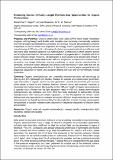Enhancing exciton diffusion length provides new opportunities for organic photovoltaics
Abstract
Organic semiconductors can potentially revolutionize solar cell technology by offering very thin, lightweight, and flexible modules for outdoor and indoor power generation. Light absorption in organic semiconductors generates a bound electron-hole pair (exciton), which needs to travel to the interface between electron donor and acceptor materials to dissociate into charge carriers. Because the exciton diffusion length in organic semiconductors is typically much shorter than the light absorption depth (∼100 nm), planar donor-acceptor heterojunctions are inefficient, and most effort has been dedicated to optimization of bulk heterojunctions with nanoscale phase separation. In this Perspective, we review recent findings and new approaches to increase the exciton diffusion length and discuss how these improvements can benefit environmentally friendly production of solar modules using organic nanoparticles or graded heterojunctions obtained by sequential deposition of electron donor and acceptor.
Citation
Sajjad , M T , Ruseckas , A & Samuel , I D W 2020 , ' Enhancing exciton diffusion length provides new opportunities for organic photovoltaics ' , Matter , vol. 3 , no. 2 , pp. 341-354 . https://doi.org/10.1016/j.matt.2020.06.028
Publication
Matter
Status
Peer reviewed
ISSN
2590-2385Type
Journal item
Description
Authors acknowledge support from the European Research Council (grant 321305) And are also grateful to EPSRC for support from grants (EP/L017008/1) and (EP/M025330/1).Collections
Items in the St Andrews Research Repository are protected by copyright, with all rights reserved, unless otherwise indicated.

